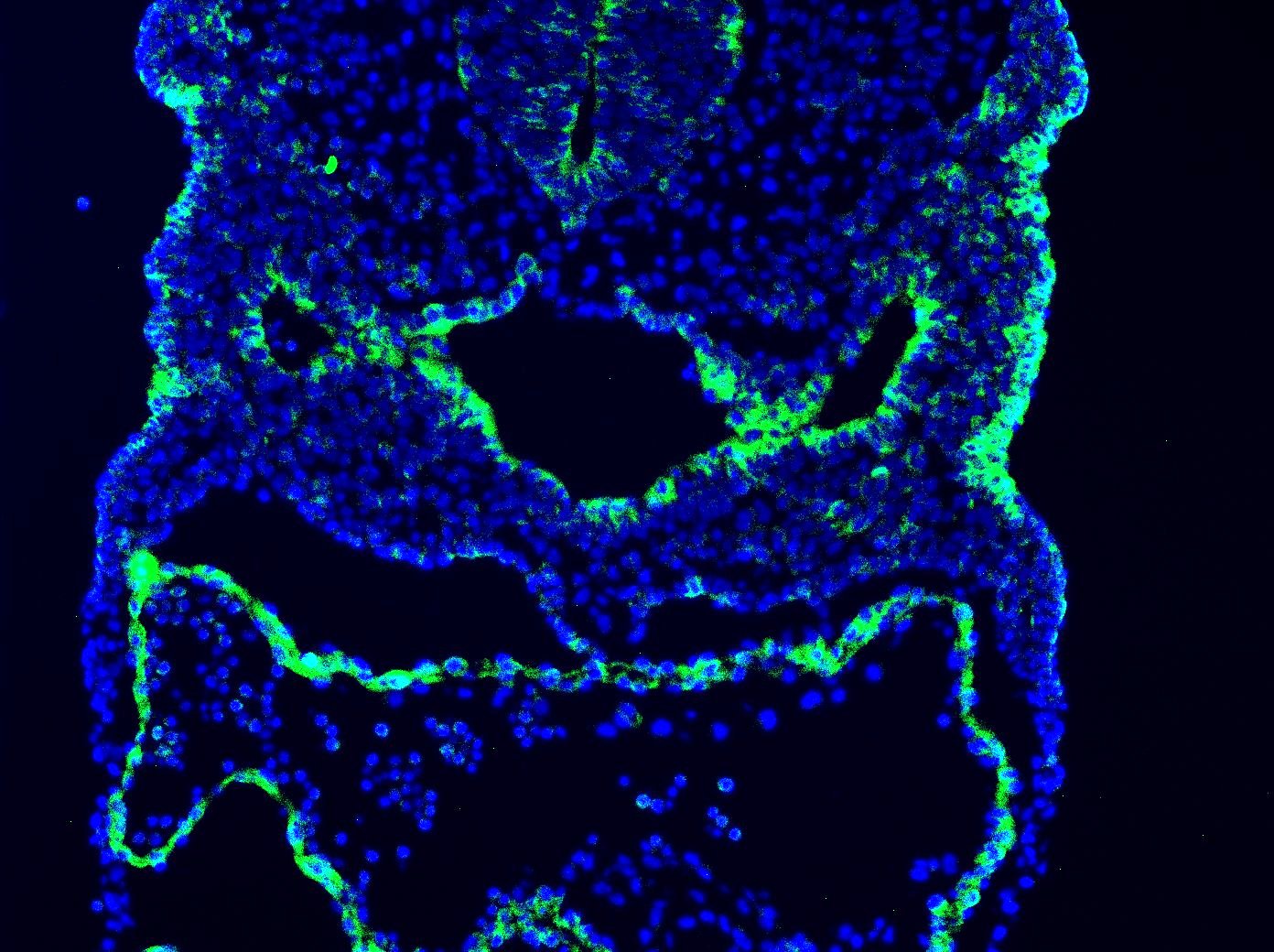Mouse FGF-10 Antibody Summary
Ser62-Thr209
Accession # NP_032028
Applications
Please Note: Optimal dilutions should be determined by each laboratory for each application. General Protocols are available in the Technical Information section on our website.
Scientific Data
 View Larger
View Larger
Detection of Human FGF‑10 by Western Blot. Western blot shows lysates of A549 human lung carcinoma cell line. PVDF Membrane was probed with 1 µg/mL of Sheep Anti-Mouse FGF-10 Antigen Affinity-purified Polyclonal Antibody (Catalog # AF6224) followed by HRP-conjugated Anti-Sheep IgG Secondary Antibody (Catalog # HAF016). A specific band was detected for FGF-10 at approximately 20 kDa (as indicated). This experiment was conducted under reducing conditions and using Immunoblot Buffer Group 8.
 View Larger
View Larger
FGF‑10 in Mouse Embryo. FGF-10 was detected in immersion fixed frozen sections of mouse embryo (E13) using Sheep Anti-Mouse FGF-10 Antigen Affinity-purified Polyclonal Antibody (Catalog # AF6224) at 5 µg/mL overnight at 4 °C. Tissue was stained using the Anti-Sheep HRP-DAB Cell & Tissue Staining Kit (brown; Catalog # CTS019) and counterstained with hematoxylin (blue). Specific staining was localized to developing spinal cord. View our protocol for Chromogenic IHC Staining of Frozen Tissue Sections.
Preparation and Storage
- 12 months from date of receipt, -20 to -70 °C as supplied.
- 1 month, 2 to 8 °C under sterile conditions after reconstitution.
- 6 months, -20 to -70 °C under sterile conditions after reconstitution.
Background: FGF-10
The Fibroblast Growth Factors (FGFs) are heparin binding glycoproteins that exert a variety of biological activities toward cells of mesenchymal, neuronal, and epithelial origin. FGF-10 belongs to the subgroup of FGFs that also includes FGF-3, -7, and -22 (1). Mature mouse FGF-10 is an approximately 20 kDa protein that contains a serine-rich region near its N-terminus (2, 3). C-terminal to this region (aa 62‑209), it shares 94% and 100% amino acid sequence identity with human and rat FGF-10, respectively. FGF-10 is secreted by mesenchymal cells and associates with extracellular FGF-BP (1, 4). It preferentially binds and activates epithelial cell FGF R2 (IIIb) and interacts more weakly with FGF R1 (IIIb) (5). The mitogenic and chemotactic properties of FGF-10 are critical in many tissues during embryogenesis. This includes limb bud initiation (6), palate development (7), branching morphogenesis and directional outgrowth of lung buds (2, 8), formation of the otic vesicle and chochlea (9), adipogenesis (10), and the development of prostate, mammary, lacrimal, and submandibular salivary glands (11‑14). FGF R2 (IIIb) signaling in these responsive tissues is similarly important during embryogenesis (7, 9, 12‑14). The expression and function of FGF‑10 are negatively regulated by Shh and BMP-4 in the developing lung (2, 8). Overlapping expression patterns and activities with FGF-3, -7, and -8 suggest at least a partial redundancy in FGF-10 biology (7, 9, 13, 14). FGF-10 induced signaling through FGF R2 (IIIb) also contributes to the progression of pancreatic cancer (15).
- Beenken, A. and M. Mohammadi (2009) Nat. Rev. Drug Discov. 8:235.
- Bellusci, S. et al. (1997) Development 124:4867.
- Tagashira, S. et al. (1997) Gene 197:399.
- Beer, H.-D. et al. (2005) Oncogene 24:5269.
- Zhang, X. et al. (2006) J. Biol. Chem. 281:15694.
- Min, H. et al. (1998) Genes Dev. 12:3156.
- Rice, R. et al. (2004) J. Clin. Invest. 113:1692.
- Weaver, M. et al. (2000) Development 127:2695.
- Pirvola, U. et al. (2000) J. Neurosci. 20:6125.
- Sakaue, H. et al. (2002) Genes Dev. 16:908.
- Donjacour, A.A. et al. (2003) Dev. Biol. 261:39.
- Mailleux, A.A. et al. (2002) Development 129:53.
- Makarenkova, H.P. et al. (2000) Development 127:2563.
- Jaskoll, T. et al. (2005) BMC Dev. Biol. 5:11.
- Nomura, S. et al. (2008) Br. J. Cancer 99:305.
Product Datasheets
Citations for Mouse FGF-10 Antibody
R&D Systems personnel manually curate a database that contains references using R&D Systems products. The data collected includes not only links to publications in PubMed, but also provides information about sample types, species, and experimental conditions.
4
Citations: Showing 1 - 4
Filter your results:
Filter by:
-
Pbx1 activates Fgf10 in the mesenchyme of developing lungs
Authors: Wei Li, Chieh-Yu Lin, Ching Shang, Pei Han, Yiqin Xiong, Chien-Jung Lin et al.
genesis
-
Taste papilla cell differentiation requires tongue mesenchyme via ALK3-BMP signaling to regulate the production of secretory proteins
Authors: M Ishan, Z Wang, P Zhao, Y Yao, S Stice, L Wells, Y Mishina, HX Liu
bioRxiv : the preprint server for biology, 2023-04-04;0(0):.
Species: Mouse
Sample Types: Whole Tissue
Applications: IHC -
Delayed application of silver nanoparticles reveals the role of early inflammation in burn wound healing
Authors: K Zhang, VCH Lui, Y Chen, CN Lok, KKY Wong
Sci Rep, 2020-04-14;10(1):6338.
Species: Mouse
Sample Types: Tissue Homogenate, Whole Tissue
Applications: IHC, Western Blot -
Generation of iPSC-derived limb progenitor-like cells for stimulating phalange regeneration in the adult mouse
Authors: Y Chen, H Xu, G Lin
Cell Discov, 2017-12-19;3(0):17046.
Species: Mouse
Sample Types: Whole Tissue
Applications: IHC
FAQs
No product specific FAQs exist for this product, however you may
View all Antibody FAQsReviews for Mouse FGF-10 Antibody
Average Rating: 4 (Based on 1 Review)
Have you used Mouse FGF-10 Antibody?
Submit a review and receive an Amazon gift card.
$25/€18/£15/$25CAN/¥75 Yuan/¥2500 Yen for a review with an image
$10/€7/£6/$10 CAD/¥70 Yuan/¥1110 Yen for a review without an image
Filter by:




